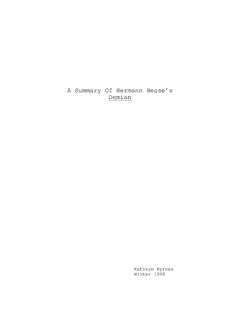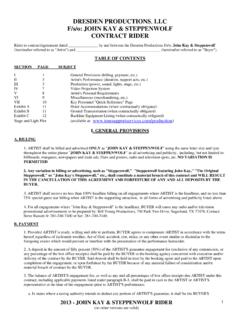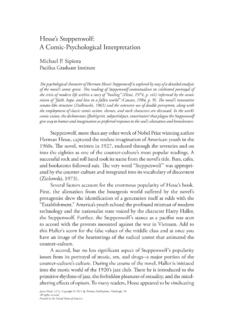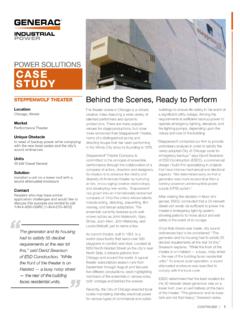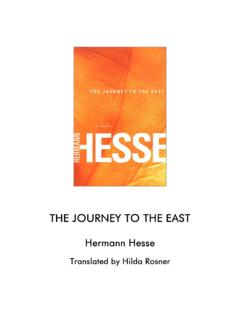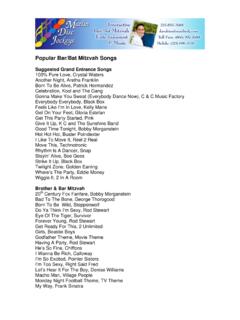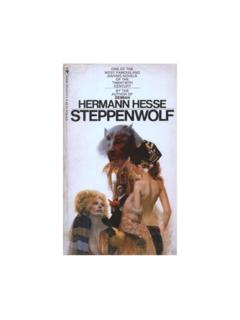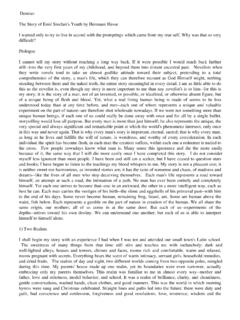Transcription of The Psychology of C.G. Jung in the Works of Hermann Hesse
1 1 HHP and E. Maier, July 1999 The Psychology of Jung in the Works ofHermann HesseAn Abridgment1byEmanuel Maier_____I. INTRODUCTIONThe purpose of this dissertation is to point out and to explain the use ofJungian symbols and Archetypes in the Works of Hermann Hesse . No claim ismade that a knowledge of Jung's Psychology is indispensable for theunderstanding and appreciation of Hesse 'a writings; nevertheleas, importantaspects of Hesse 's Works need to be clarified by reference to Jung. Thestrong emotional appeal of certain situations in Hesse 's Works , which arestrange and mysterious to the logical mind, can be ascribed to the Archetypes,which, if Jung is correct, affect the reader whether he is conscious of them An attempt shall be made here to explain in terms of the Psychology ofCarl Gustav Jung what appears to many as obscure mysticism or is the writer's opinion that many characters in Hesse 's Works representaspects or personified contents of the unconscious.
2 An individual becomesaware of these contents in the form of projections upon others, or asmythological I shall demonstrate this in the light of Jung 's psychologyin Chapter II, using Demian as the origin and development of some of Hesse 's characters can be traceddirectly to the analytical sessions with Dr. Lang, a student of III deals with these early writings and demonstrates the development 1 [Abridgment by Emanuel Maier of his 1953 dissertation in the Department of German,submitted to the Faculty of the Graduate School of Arts and Science in partialfulfillment of the requirements for the degree of Doctor of Philosophy.]
3 New YorkUniversity, Washington Square, New York. Dr. Maier's dissertation was neverpublished. The manuscript is located at the Schiller Nationalmuseum in Marbach,Germany. This abridgment is being posted by HHP on the internet with the kindpermission of Dr. Maier. ED]2 Compare "Psychologie und Dichtung," Jung, pp. 324, 325 in Philosophie derLiteraturwissenschaft, edited by Emil Ermatinger, Junker und D nnhaupt Verlag,Berlin, 1930. Also H. Mauerhofer, Die Introversion, mit speziellerBer cksichtigung des Dichters , , Ibid such Archetypes as the "Anima", the "Shadow", the "Chaos", etc. This issupported by Hesse 's biographer Hugo Hesse himself refers in hisletters to the "new note" which he struck in Demian which has its origin in theM rchen collection5 of which "Traumfolge" and "Der schwere Weg" are claims to have had a direct influence upon Siddhartha andSteppenwolf in the course of analytical sessions with emphasis in this dissertation is upon interpretation in the light ofJungian Psychology without evaluation of the aesthetic and literary merits ofHesse's work .
4 Such an undertaking has the full endorsemant of Jung asexemplified by the fact that a similar investigation of Hoffmann's "Dergoldene Topf" by Aniela Jaff has been incorporated by Jung in Gestaltungendes Unbewussten, Rascher Verlag, Zurich, relationship between psychological origin and the aesthetic value ofa work is another subject, and is discussed by Jung in his Thisdiscussion does not fall properly within the scope of this , we are not concerned here with the validity of thepsychology of C. G. Jung as such. Such a discussion properly belongs in the 4 Hugo Ball, Hermann Hesse , Sein Leben und sein Werk, Fretz und Wasmuth, Zurich,1947; p.
5 Same claim is made by Kunze in a recent study Lebensgestaltung undWeltanschauung in H. Hesse 's Siddhartha, Malinberg, Herzogenbusch, 1949, :"Hier (bei Hesse 's Auffassung von Jean Pauls Beziehung zumUnbewussten) stehen wir mitten im "kollektiven Unbewussten"Jungs, dessen Einfluss sich bei Hesse st rker bemerkbar macht alsder Freuds, wie "gross des Dichters Bewunderung vor demGr nder der psychoanalytiachen Schule auch sein mag. Jung, dernicht im blossen Erkennen des Unbewussten, oder dessenBek mpfung durch willensvolles Handeln, sondern durch Bejahungder aus den Tiefen der Seele aufsteigenden Flut von Trieben undRegungen Heil und Rettung sah, Jung hat das innere Leben desDichters in den Kriegsjahren weitgehend beeinflusst.
6 Von ihm bernimmt Hesse die Lehre, dass das Unbewusste die Aufgabe hat,das zu eng gewordene Bewusstsein zu erg nzen, wieder weit zumachen."5 Hermann Hesse , Briefe, Compare Jung's and Hesse 's letters in Introduction [of the ], p.[ ] and [see also , Briefe II, 1946-1955,ed. Aniela Jaff , Olten: Walter, 1972, ; also in: Benjamin Nelson, "Hesseand Jung. Two Newly Discovered Letters", The Psychoanalytic Review, vol 50,1963, 's article also contains Hesse 's response after E. Maierhad sent him a copy of Jung's letter. Hesse said that, as a friend of discretion, hehad not read of Psychology and not in that of the ideas of Dr.]
7 Jung have had profound influence upon thecreative work of Hermann Hesse , other influences are not thereby dissertations might wish to examine the influence of Ludwig Klages,8 Sigmund Freud, or Oriental philosophy, or of German H. Mauerhofereven went so far as to characterize all of Hesse s Works as the expression A man of the stature of Hermann Hesse is open to all theintellectual and cultural achievements of man. He has taken from all and hasgiven back to the world a new synthesis which bears the imprint of his owncreative DEMIAN Ich wollte ja nichts als das zu leben versuchen,was von selber aus mir heraus wollte.
8 Warum wardas so sehr schwer? This is the motto of Hermann Hesse s novel which was written in was first published as an autobiography in Berlin in 1919 under thepseudonym Emil Sinclair. Not until 1920, for the ninth edition, was the novelpublished under his own name. The name Emil Sinclair was to symbolize anew beginning for the The following quotations are from the undatededition by Fretz and Wasmuth, Zurich, copyrighted Matzig refers to Demian as the Geburt eines Mythos .12 Einre1igi ses Urerlebnis ist gesta1tet , says Hugo Der Roman Demianenth lt .. nichts anderes als Inhalt und Ergebnis vieler aufeinanderfolgenderpsychoanalytischer Sitzungen , says Berta , Sinclair s way to himself is like the journey of the mythologicalhero whom his own fate has sent forth.
9 On that journey he meets with thesymbolical figures which are the obstacles to be conquered and at the sametime the milestones marking his Jung maintains that everyindividual psyche, in the process of individuation produces an individual 7 See for instance: "Psychologie und Dichtung" in Philosophie derLiteraturwissenschaft; also Seelenprobleme der Gegenwart, Rascher Verlag Max Schmid, Hermann Hesse , Weg und Wandlung, Fretz und Wasmuth Zurich, H.
10 Ball, p. H. Mauerhofer, pp. 43, Hermann Hesse , eine bibliographieche Studie, von Horst Kliemann und Karl , p. Richard Matzig, Hermann Hesse in Montagnola, p. Ball, p. Berger, p. Geheimnis der goldenen Bl te, pp. 22, which is parallel to the great mythologies of all All symbolsand rites, the treasury of ideals of mankind, have their origin in theunconscious of the soul, meditates while under the influence of the 35 year old Catholic psychiatristDr. Lang,18 Demian is a novel of individuation par excellence. Thestages of the journey to self-realization are the various chapters.
